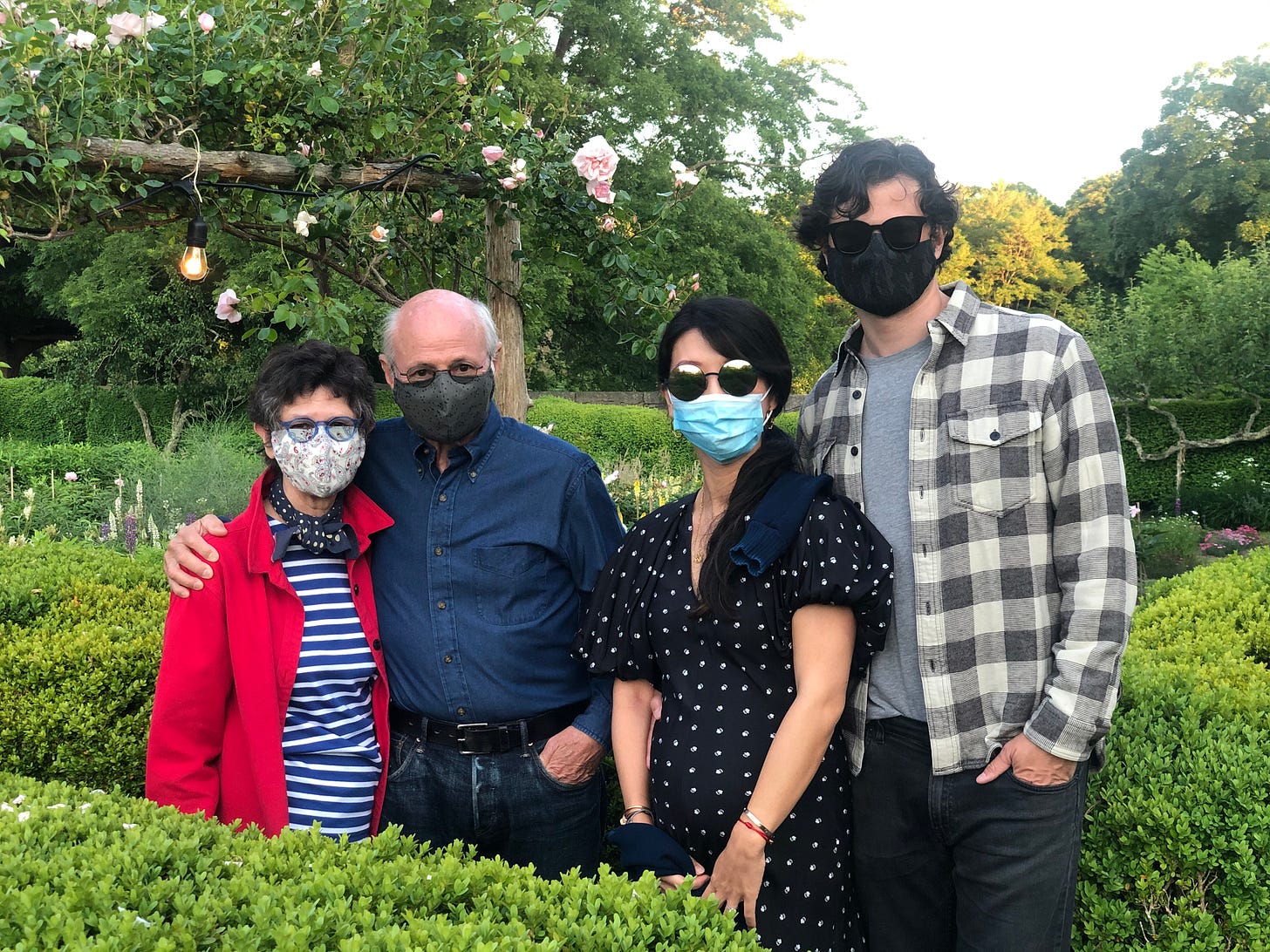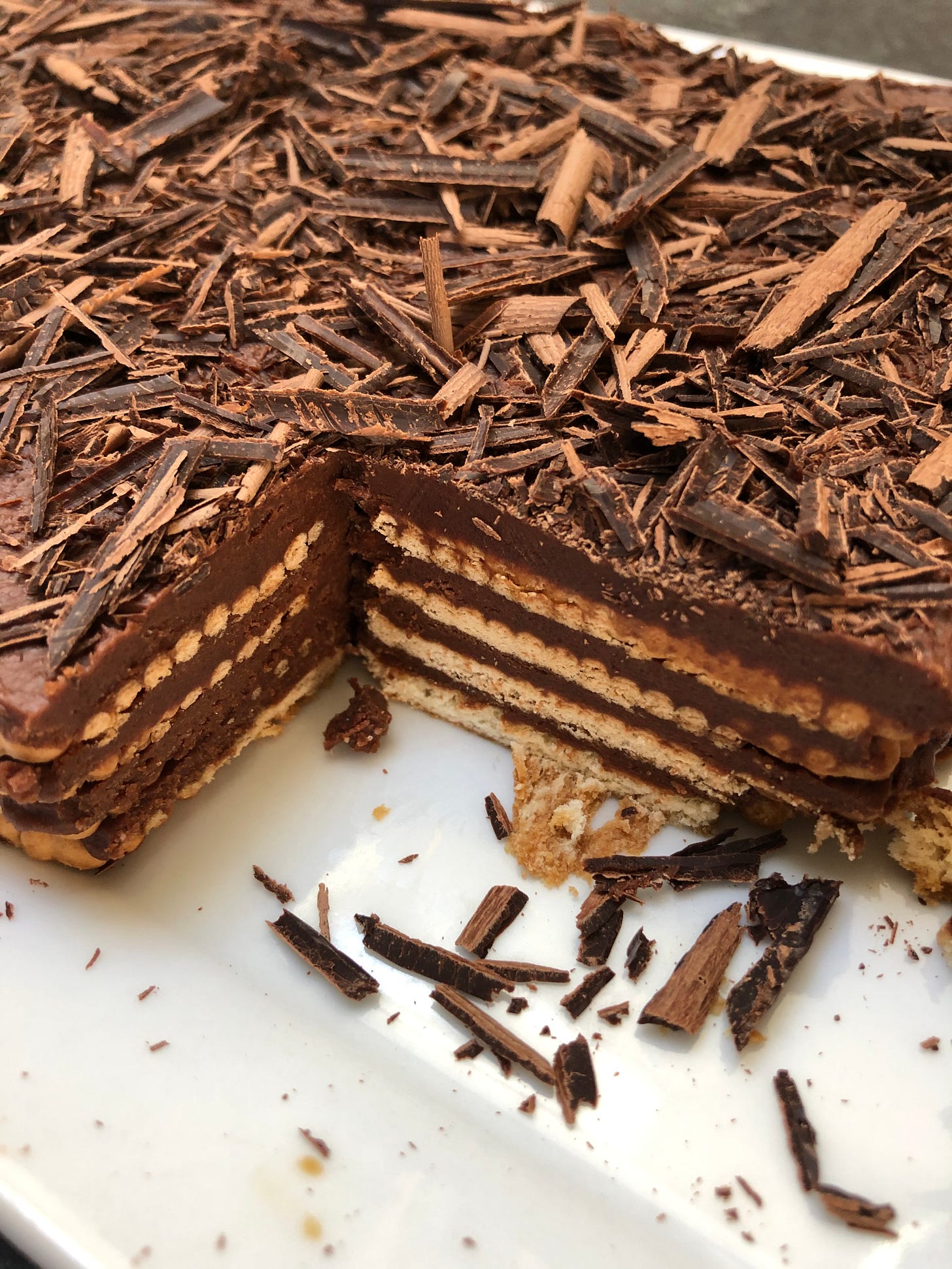Hello! Hello!
I’m back in America, but as always, I’ve still got Paris things I want to tell you about — and I will. But for the last week or so I’ve been thinking about COVID — thankfully not because anyone in my family has it (I’m knocking on wood as I’m typing this), but because it was in this month, four years ago, that the World Health Organization declared the virus a pandemic. Days later, Joshua, our son, and Linling Tao, our daughter-in-law, who was pregnant with their first child, came to live with us in Connecticut.
It was, to draw from Dickens, “the best of times” — it was a gift to be together; and it was “the worst of — fear and anxiety hovered around us. Now, with everyone healthy – Gemma was born in August, days after Joshua and Linling returned to New York City to be close to the hospital — and with Gemma’s sister VV in our lives (she’ll turn 2 next month), the feelings of fear are mostly soft around the edges and hazy; the feelings of joy, the deep gratefulness and the understanding of how lucky we were (and are) resonate with more clarity and more strength.


Because Sam Sifton, the founding editor of NYT Cooking, highlighted one of my recipes in a recent newsletter, I went to look at it (it’s one of my favorite icebox cakes) and to read the story I’d written to go with. It was published in the New York Times Magazine in May 2020, when I was a columnist, and it was about Joshua and Linling coming to live with us. It was about gratitude and also about fear. But mostly it was about sharing food together.
I’m reprinting the story here — the recipe too — because when we’re lucky enough to have made it through hard times, it’s good to recall them, and to pick out the moments of happiness that were woven into them.
It’s also good to remember how powerful the food we make and share can be.
Rewinding to 2020…
And so now we are four: On March 17, days after New York City “paused,” our son, Joshua, and daughter-in-law, Linling, came to live with us in our house in eastern Connecticut. Joshua was in preschool when we bought the house, and back then, we’d come here for weekends. His Lego villages are still intact, the models he built are still on shelves and there are still enough of his T-shirts around for him to grab one and go practice foul shots.
But ever since Michael, my husband, and I moved here fuller time about a dozen years ago, we’ve claimed corners of the small house for ourselves. Joshua’s childhood bedroom is now Michael’s office, as well as the room with the TV. There are bookcases everywhere and chocolate in cool, dark places upstairs and down. While there are enough plates, bowls and serving dishes to set the table for a banquet, the house can’t hold a crowd. It’s doing the best it can with four of us here. So are we.
I tried to convince myself that Joshua and Linling were here because they wanted to leave New York, but I always knew the truth: They came because they were worried about us, because they realized for the first time that we are older than we feel, older than we act and old enough to be at a greater risk from the effects of the coronavirus. They came to help us, to shop so that we wouldn’t have to leave home, to keep us safe. I fumble trying to find the words for my gratefulness and come up short trying to show it, so I cook. For them, for us and for myself — knowing that I’ll be cooking dinner for my family sustains me.


I cook most, but not all, nights. Michael makes pizza every Tuesday. Joshua and Linling make elegant pasta dishes and vegetable plates on the weekend. Linling makes the salad every night — I love how her palate tips bitter and how smart she is about mixing things when we’re short on greens, as we are a lot lately. I make food from cookbooks I never opened before, from recipes I created a long time ago and haven’t thought about for years, from inspiration, from whim, from necessity: the wrinkled apple and the sprouted onion were braised with a chicken. When I made the Moka Dupont for dessert, the kids were as surprised by it as I was when I first tasted it.
The recipe comes from Bernard Collet. Bernard and his wife, Martine, Parisians, have been our friends for 40 years. We’ve eaten at each other’s homes countless times. (Well, countless for me, but knowable for Martine, who keeps handwritten notebooks detailing the meals she cooks for dinner parties.) Given how long we’ve known each other, it’s odd that it was only 10 or so years ago that I learned about the Moka Dupont, the cake that Bernard often has on his birthday and the one he often makes for family celebrations. When Bernard served it to us, I missed a beat before smiling. I’d been expecting a cake-cake, something tall, soft, frosted and fit for candles. I was waiting for a gâteau but got four layers of cookies held together with four layers of frosting. Bernard’s cake is an old-fashioned icebox cake! It’s homey — it’s meant to be — with a sleek, spare look.
The first person in Bernard’s family to make the cake was his grandmother, who got the recipe from her neighbor, a Madame Dupont, from whom the dessert gets its name. Bernard thinks he had his first Moka Dupont in the 1950s, maybe for his 5th birthday. The recipe, as it was given to Bernard and as he always makes it, calls for Thé Brun cookies, store-bought tea biscuits that are common in France. (I think it might have been a back-of-the-box recipe, since I’ve come across similar ones, but Bernard holds to his family’s story, and I like that.) The cookies are dipped in espresso — the “Moka” — arranged on a platter and then smoothed with a thin layer of chocolate buttercream. The buttercream is very sweet, but the espresso is very strong. They bring out the best in each other. Bernard runs a fork across the last swish of frosting, his hallmark on the cake. I don’t, and he seemed a bit disappointed when he saw that I topped the cake with grated chocolate.
I’ve made other changes. I couldn’t find Thé Brun in America, so I constructed the cake with Petit Beurre cookies. And now I can’t even find those. My latest Moka Dupont was made with Nabisco Social Teas, an exceedingly plain cookie that’s even older than the recipe. While Bernard is precise about the type and number of cookies he uses, the layout and the layers, the top decoration and the amount of seconds each cookie should be dipped in the coffee (too long and the cookies are too soft; too short and you don’t get enough flavor), I take a more casual approach, one that felt quite American to me when I first made the cake and one that’s perfect for this moment. I consider the recipe a template, using whatever cookies I’ve got and sometimes just making little sandwiches rather than a whole cake.
Every time I make a Moka Dupont, I remember how delighted Bernard was when he presented the cake to us. I feel the same delight sharing his cake with my family, passing it on to another generation, offering it as comfort during complicated times. And so I bring this pretty cake to them as a treat and a thank you, hoping that when they recall these months, they’ll remember the sweetness of sharing something simple, made by hand, just for them.
MOKA DUPONT

INGREDIENTS
1/2 cup (115 grams or 1 stick) unsalted butter, at room temperature
1/2 cup (100 grams) plus 1 tablespoon granulated sugar
1 large, very fresh egg (preferably organic, since it will not be cooked)
3 ounces (85 grams) bittersweet chocolate, melted and cooled
1/2 cup (120 milliliters) hot espresso (made fresh or with instant espresso powder)
64 Nabisco Social Tea Biscuits (from 1 12-ounce package), or other plain, preferably flat cookies
Grated chocolate, for decoration
Makes 8 servings
DIRECTIONS
Before you start assembling the cake, decide on the size you want. I make a cake that’s 4 cookies wide, 4 cookies long and 4 layers high. Choose a plate to build and serve the cake.
Make the buttercream frosting: Put the butter in a small bowl, and beat it with a flexible spatula until smooth. Add ½ cup sugar, and beat again with the spatula until it’s thoroughly incorporated. Separate the egg, putting the yolk in a cup and the white in a small bowl. Whip the white until it holds soft peaks using a mixer or, for a short but strenuous exercise, a whisk. Give the yolk a quick whisk, just to break it up, then stir it into the white.
Add the egg to the bowl with the butter, and using the spatula, stir and fold until blended. Scrape in the melted chocolate, then stir and fold again until the frosting is homogeneous. (It won’t be perfectly smooth.) Taste the buttercream, and you’ll feel grains of sugar on your tongue — that’s the way it’s meant to be.
Pour the hot espresso into a wide, shallow bowl, and stir in the remaining 1 tablespoon sugar.
One by one, drop each cookie into the espresso, count 3 seconds, flip it over, count 3 seconds more, then place the espresso-soaked cookie on the serving plate. Continue until you have your first layer of cookies in place.
Using a small offset spatula or a table knife, spread a quarter of the buttercream over the cookies, working the cream to the edges of the cookies. Build 3 more layers of dunked cookies and smoothed buttercream. Top the last layer of buttercream with grated chocolate.
Refrigerate the cake until the frosting is set, at least 3 hours.
STORING: The cake can be kept covered in the refrigerator for up to 3 days. (Once the frosting is set, the cake could also be wrapped airtight and frozen for up to 2 months. To serve, simply let it defrost, still wrapped, in the refrigerator for about 4 hours or at room temperature for about 1 hour.)













Dorie, Your writing is heartfelt, generous and humble. Thank you for sharing. Good food is so much more than just nourishment; it's an expression of love. What a blessing to give, and receive such love!
Thank you for your gentle and caring way of being, Dorie. We have all been traumatized in some way by what we've been through and the way life happened anyway (losses, births) sometimes the grief bleeds like watercolors on paper and keeps going. It's good to remember that we can still find and remember the joy, create new good memories, and share sweets.